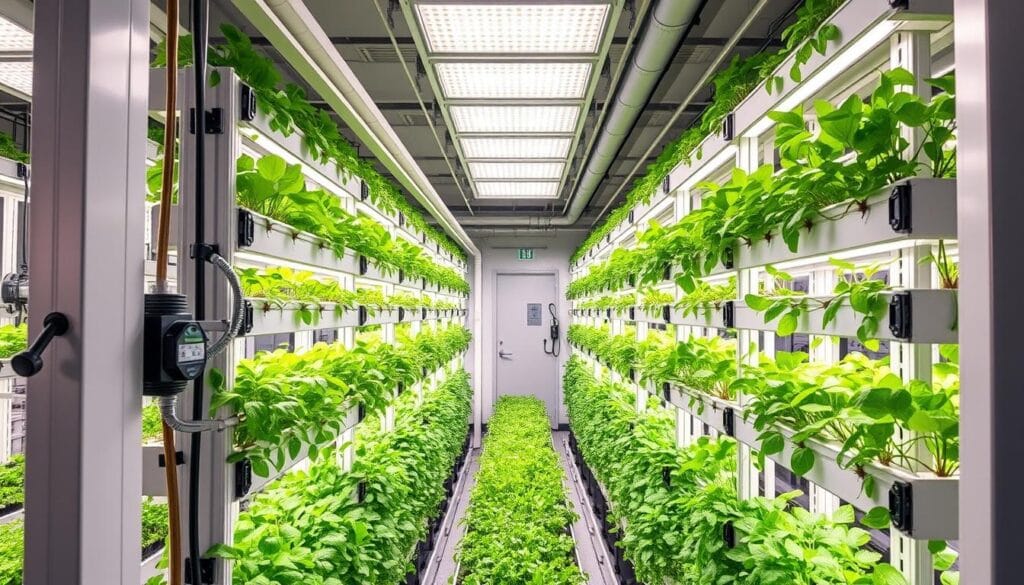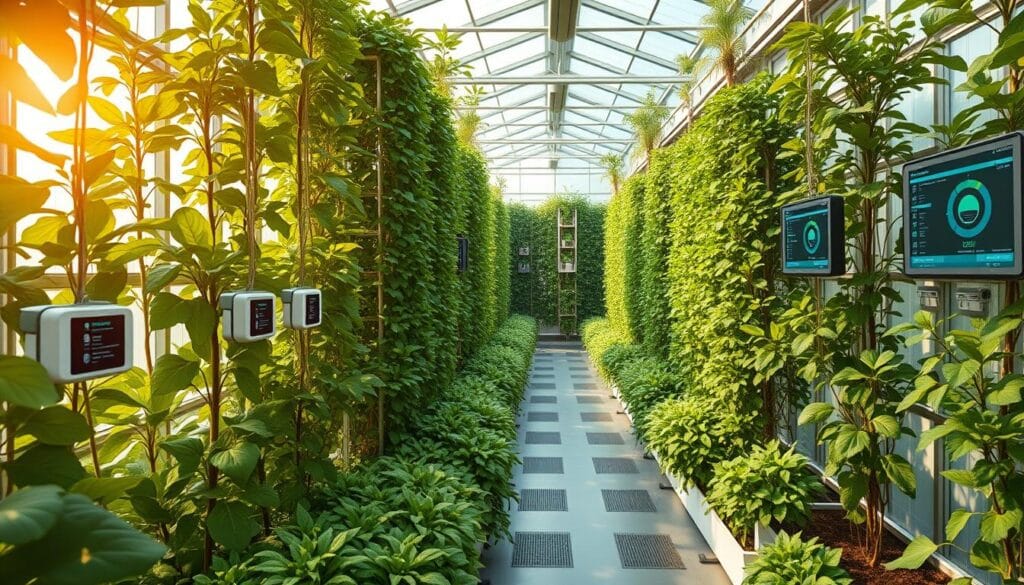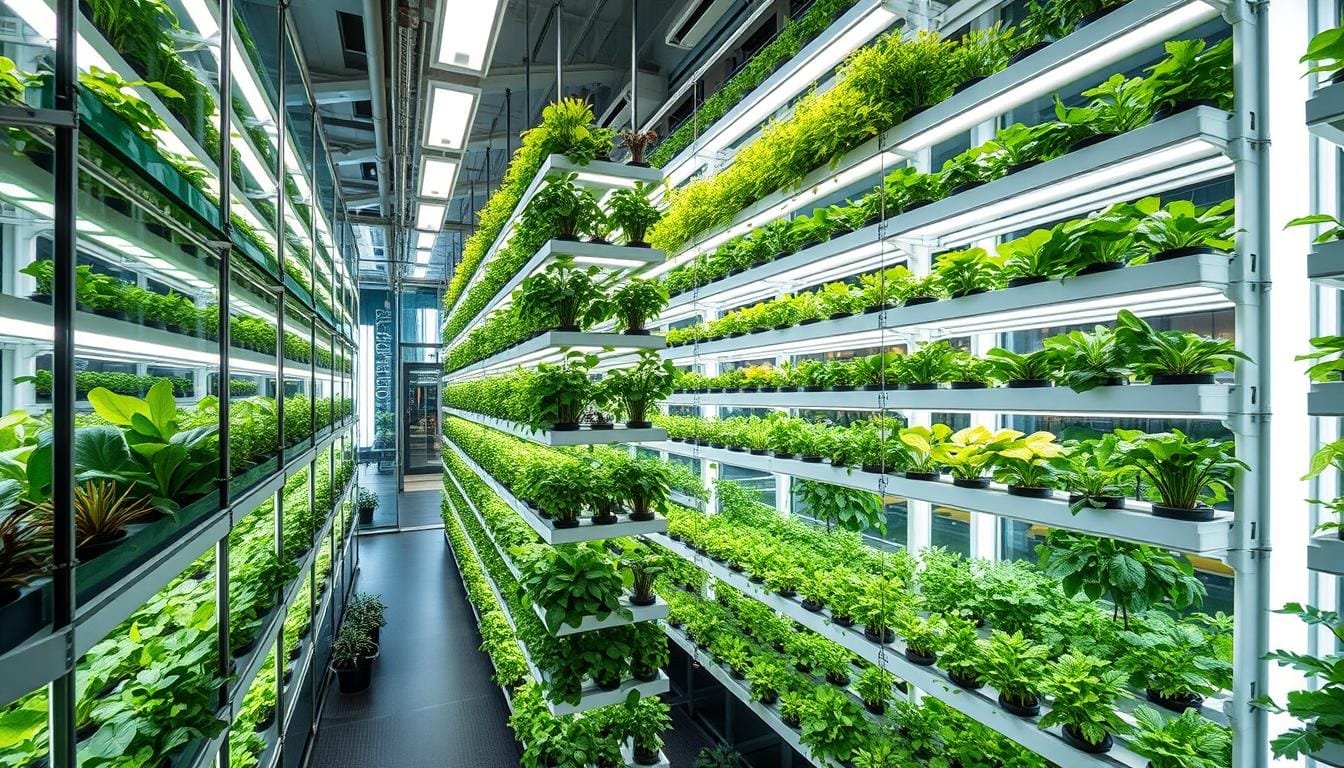Step into the future of farming and discover vertical farming. It solves global food security issues like soil loss, land scarcity, and water problems. Imagine growing lots of fresh, local food with little environmental harm. Welcome to vertical farming, where endless possibilities await in every vertical inch. Explore Vertical Farming Trends and see how innovation is transforming agriculture.
Key Takeaways
- Vertical farming can increase crop yields by 70-80 times compared to traditional farming methods.
- Hydroponics and aeroponics are highlighted as sustainable solutions to address challenges like soil degradation and limited productivity.
- The vertical farming market is expected to grow from $9.742 billion in 2024 to $18.690 billion in 2029, at a CAGR of 13.92%.
- North America is anticipated to have a significant market share in the vertical farming industry, with Asia Pacific witnessing the fastest growth.
- Investments in advanced vertical farming technologies, such as Oishii Mega Farm’s $15 million loan and Vertical Harvest’s $59.5 million project financing, are driving the industry forward.
Understanding Modern Vertical Farming Evolution
Vertical farming has a long history, starting with the Hanging Gardens of Babylon. In the 1930s, William Gericke began working on soilless gardening, a key step for today’s hydroponics. Gilbert Ellis Bailey first used the term “vertical farming” in 1915, for deep soil cultivation. Now, vertical farming is a leading industry, solving the global food security problem.
Transition to Modern Hydroponic Systems
The world’s population is growing fast, with 9.7 billion people expected by 2050. We need better ways to grow food. Vertical farming, growing crops in layers, is a key solution. It’s more efficient with nutrients and water, overcoming traditional farming’s limits.
Current State of Vertical Agriculture
Vertical farming now includes many systems, like big Plant Factories with Artificial Lighting (PFAL), container farms, in-store farms, and even home or office farms. These use the latest tech, like LED lights, climate control, and automated feeding. This way, vertical farming can grow 70-80 times more than regular farms. It’s crucial for sustainable food production and urban food security.
| Vertical Farming Technique | Description |
|---|---|
| Plant Factory with Artificial Lighting (PFAL) | Industrial-scale vertical farming systems with advanced lighting, climate control, and automated nutrient delivery. |
| Container Farms | Modular vertical farming units housed in shipping containers, enabling innovative farming methods in urban settings. |
| In-Store Farms | Compact vertical farming systems integrated within retail stores, providing fresh produce directly to consumers. |
| Appliance Farms | Vertical farming setups designed for home or office use, bringing sustainable food production closer to the end-user. |
The Technology Driving Vertical Farming Systems
Vertical farming is changing agriculture with new technologies. These technologies allow for precise control and high efficiency. They use hydroponics, aeroponics, and controlled environment agriculture (CEA) to grow crops without soil.
These methods save water and nutrients and let crops grow all year. They work well even in cities.
The Internet of Things (IoT) is key in vertical farming. It connects sensors and devices for real-time monitoring. This lets farmers manage growing conditions from anywhere.
LED lighting has made vertical farming more efficient. These lights can mimic natural sunlight. They help plants grow better and use less energy.
With these lights and climate control, vertical farms can grow crops all year. They don’t depend on outdoor weather.
| Technology | Benefit |
|---|---|
| Hydroponics | Efficient water and nutrient delivery, reduced land use |
| Aeroponics | Highly targeted nutrient application, increased oxygenation |
| Controlled Environment Agriculture (CEA) | Precise control over growing conditions, year-round production |
| IoT and Cloud-based Platforms | Remote monitoring, data-driven decision making, and automation |
| LED Lighting | Energy-efficient, customizable spectrum for optimal growth |
Vertical farming technology is getting better fast. It helps farmers grow food in new ways. We’ll see more improvements in aeroponics, smart sensors, and control systems soon.
Vertical Farming Trends United States: Market Analysis
The vertical farming industry in the U.S. is growing fast. This growth comes from people wanting fresh, pesticide-free food. Companies like Plenty Unlimited Inc., Bowery Farming, and AeroFarms are leading the way. They’re getting a lot of money from investors.
These companies are helping solve the problem of food deserts. They’re making sure cities have access to healthy food. They’re doing this with new ways of growing food.
Growth Projections and Market Size
The global vertical farming market was worth USD 8.47 billion in 2022. It’s expected to hit USD 59.13 billion by 2031. This is a growth rate of 24.1% from 2023 to 2031.
In the U.S., the market was USD 1.64 billion in 2023. It’s expected to reach USD 25.99 billion by 2034. This shows how important urban agriculture and sustainable food production are becoming in the U.S.
Key Industry Players and Investments
Companies like Plenty Unlimited Inc., Bowery Farming, and AeroFarms are at the forefront. They’re getting a lot of money from investors. This money is helping them grow and innovate.
In January 2023, Siemens teamed up with 80 Acres. They used artificial intelligence and machine learning to improve crop growth in vertical farms.
Regional Distribution of Vertical Farms
Vertical farms are mostly found in cities. This is because there’s little land for farming in these areas. North America, especially the U.S., is leading in this trend.
This shows the industry’s effort to solve food deserts. They’re using urban agriculture to make sure everyone has access to fresh food.
| Metric | Value |
|---|---|
| Global Vertical Farming Market Size (2022) | USD 8.47 billion |
| Projected Global Vertical Farming Market Size (2031) | USD 59.13 billion |
| Global Vertical Farming Market CAGR (2023-2031) | 24.1% |
| U.S. Vertical Farming Market Size (2023) | USD 1.64 billion |
| Projected U.S. Vertical Farming Market Size (2034) | USD 25.99 billion |
| U.S. Vertical Farming Market CAGR (2024-2034) | 28.5% |
Advanced Hydroponic System Components
The vertical farming world is growing fast. Modern hydroponic systems now have advanced parts to help plants grow better. These systems are key in controlled environment agriculture (CEA), aiming for high yields and less environmental harm.
Nutrient delivery is at the core of these systems. It gives plants the right mix of nutrients for growth. pH and EC monitors keep the nutrient solutions balanced, helping plants grow strong.
Special growing media like rockwool or coir support plant health. These media work with the nutrient systems to create a perfect growing space for crops.
CO2 monitoring and control are also part of these systems. They help plants grow by keeping CO2 levels just right. This control is a big part of top-notch vertical farming, leading to better yields and quality.
With more people wanting sustainable, local food, these advanced hydroponic parts are vital. Today’s vertical farmers are changing how we produce and share food.

“The future of farming lies in the precise control and optimization of every aspect of the growing environment. Advanced hydroponic systems are the key to unlocking the full potential of vertical farming.”
– Dr. Emma Greenfield, Lead Researcher, Center for Urban Agriculture
Sustainable Production Methods in Vertical Farming
Vertical farming is changing how we grow food. It tackles problems like land and water shortages. It also focuses on using resources wisely.
Water Conservation Techniques
Vertical farming is great at saving water. It uses systems that recycle water, cutting water use by up to 95%. Eden Green Technology uses 98% less water than old farms, thanks to its water recycling.
Energy Efficiency Solutions
Energy use is key in vertical farming. It uses special LED lights and climate control to save energy. Eden Green Technology consumes 90% less light energy compared to other vertical farming systems.
Waste Management Systems
Vertical farming also manages waste well. It composts and recycles nutrients. Eden Green Technology even gives 10% of its food to those in need, showing its commitment to sustainability.
But, vertical farms still have a big carbon footprint. This is mainly because of the energy needed for lights and climate control. Yet, the industry is working hard to use solar and wind power to lessen its impact.
“Vertical farming has the potential to revolutionize the way we approach sustainable food production, offering a solution to the pressing issues of resource scarcity and environmental degradation.”
IoT Integration in Modern Farming Systems
The Internet of Things (IoT) is changing vertical farming. IoT systems let farmers watch and control things like temperature, nutrient levels, and plant health in real time.
Precision farming techniques use IoT to gather data from sensors. These sensors track things like temperature, humidity, and CO2 levels. This info helps farmers adjust growing conditions to boost yields and save on labor costs.
- IoT sensors check soil moisture, humidity, temperature, and nutrient levels for smart agriculture management.
- IoT drones do detailed checks on crops, livestock, weather, and field conditions.
- Wearable IoT devices track livestock health and location, helping with data-driven farming choices.
But, using IoT in farming has its hurdles, like connectivity problems in rural spots and energy needs. Still, the benefits are big. IoT in farming could make farming more sustainable, productive, and shape the future of precision agriculture.
“The IoT technology in agriculture is expected to witness significant growth, with an increase in the adoption of IoT solutions due to the need for sustainable agricultural practices and advancements in technical capabilities.”

As farming keeps changing, IoT will team up with new tech like artificial intelligence and 5G. This will change precision farming techniques and open up new chances for smart agriculture and data-driven farming.
Crop Selection and Optimization Strategies
In vertical farming, choosing and optimizing crops is key to high yields and better food for cities. Farms focus on quick-growing, valuable crops like leafy greens and herbs. Lettuce, spinach, kale, and strawberries do well in these controlled spaces.
Research looks into growing staple crops like wheat and rice in vertical farms. Surprisingly, these crops can yield 10 to 60 times more than usual. This shows how vertical farming can help solve food security issues in cities.
Yield Optimization Techniques
Getting the most from vertical farming requires careful attention to several factors. Light, nutrients, and environment must be just right. Using smart climate control can improve growth, efficiency, and cost.
Also, treating crops at the end of production can make them last longer and be healthier. This ensures the food from vertical farms is not just plentiful but also top-notch.
Vertical Microgreen Farming
Vertical microgreen farming is a new way to grow food in cities. It uses young, edible greens in small spaces. This method is great for areas with little land and no access to fresh food.
By 2050, the world’s population is anticipated to grow to approximately 9.8 billion people. We need better ways to grow food. Vertical farming, with its focus on valuable crops and efficiency, is a big part of the solution.
Environmental Control and Monitoring Systems
The controlled environment agriculture industry in the United States is booming. It has grown from about 1,400 operations in 2009 to nearly 3,000 in 2019. Advanced environmental control and monitoring systems are now key. They help vertical farms grow crops efficiently and sustainably.
These systems manage important factors like temperature, humidity, CO2 levels, and light. By controlling these, growers create the perfect environment for their crops. This leads to healthier plants, better nutrient uptake, and faster growth.
Monitoring systems also track how plants are doing in real-time. This helps farmers make smart choices and improve their farming methods.
Reducing greenhouse gas emissions is also a big focus for vertical farms. They use systems to keep CO2 levels just right. This helps plants grow well and reduces the farm’s environmental footprint.

